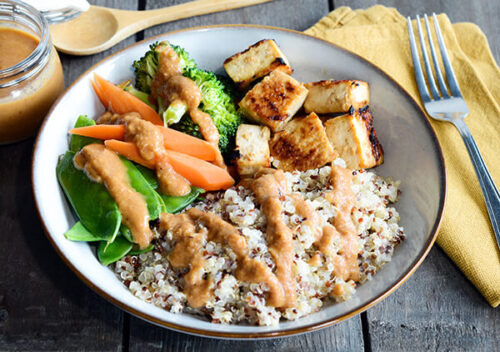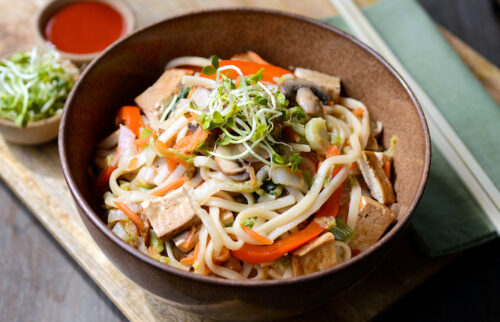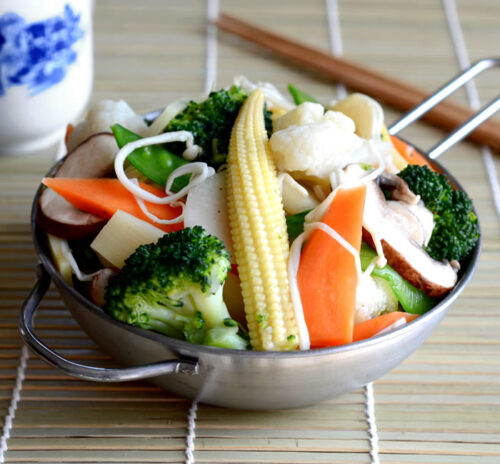Thai Vegetables with Couscous
By Cathy Fisher
This dish may be served as a salad or entree. It is flavored with distinctive Thai ingredients, including garlic, ginger and soy sauce. The couscous and hearty vegetables-broccoli, cabbage, carrots and mushrooms-are sure to fill you up without leaving you heavy.
Serves: 4
Prep Time: 25 min
Cook Time: 25 min

Ingredients
3 Cups
Water
1 Cup
Dry Israeli (large) couscous
2 Cloves
Garlic
1 Tbsp
Fresh ginger, minced
2 Tbsp
Peanut butter
1 Tbsp
Soy sauce (optional)
1/4 Cup
Water
1/2 Cup
Water and more as needed
2 Cups
Small broccoli florets
3
Carrots, thinly sliced or julienned (like matchsticks)
8
Mushrooms, diced
1/2
Head of cabbage, thinly sliced
1 Cup
Frozen green peas (thawed)
1/2 Cup
Fresh cilantro, chopped
4
Green onions, chopped
Directions
1
Chop and prepare all of your ingredients beforehand, as this dish cooks up quickly once it is started.
2
To cook the couscous, bring 3 cups water to a boil then add dry couscous. Cook for 10 minutes until cooked through (a little al dente is better than over-cooked). Drain and rinse with cool water.
3
While couscous is boiling, blend sauce ingredients, garlic, ginger, peanut butter, soy sauce and water, in a high-speed blender until smooth (check that peanut butter is completely incorporated). Set aside.
4
In a large pot or skillet, add about 1/2 cup water along with the broccoli, carrots and mushrooms, and cook on medium-high for about 5 minutes to begin softening. Add the cabbage and peas, and cook for another 5 minutes, until the broccoli, carrots and cabbage are softened (adding a bit more water if needed to prevent any sticking).
5
Add the sauce, couscous, cilantro and scallions to the vegetables, and thoroughly mix through, cooking another minute or two. Remove from the heat, and serve hot or warm. Garnish with cilantro or hulled sesame seeds.
Notes: Israeli couscous is a wheat pasta shaped into small balls, found in bags or bulk sections of health food stores. Frozen peas work best, as they maintain their firm texture better than canned; but canned or fresh can also be used. If you are not a fan of cilantro, parsley or basil may be used in its place.
6
Substitutions: If you are trying to avoid sodium (in soy sauce), wheat (in couscous and soy sauce), and/or peanuts (a common allergen), you can make the following substitutions: For soy sauce, reduce the amount and add more water to make up the difference, or use all water. For the couscous, use two or so cups cooked brown rice or cooked whole-grain pasta shells (quinoa and rice pastas are great) and add 1/4 more cup of water to sauce mixture. Instead of peanut butter, use 3 tablespoons tahini (ground sesame seed paste) or 3 tablespoons hulled sesame seeds.
Print Recipe
Print With Images
Print Without Images
Struggling to make healthy eating stick? Get practical guidance, exclusive recipes and community support by joining our Starch Solution Community.









Join the Conversation!
Whether you’ve tried the recipe, have a question or want to share your own healthy twist - your voice matters.